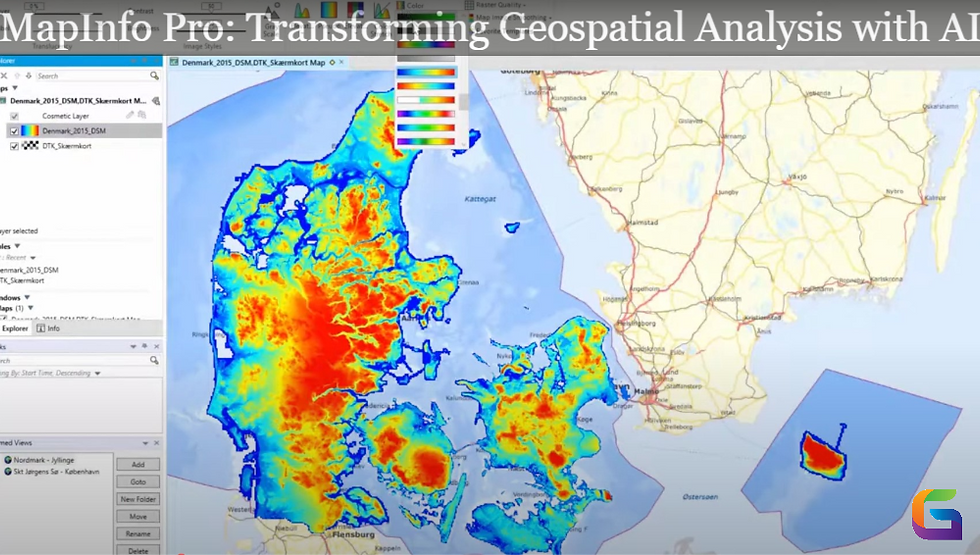Machine Learning for Geospatial Data
- utkalsharma
- Feb 21, 2023
- 3 min read
Updated: May 27, 2024
Deep learning or Machine learning has become a popular approach for analyzing geospatial data due to its ability to learn complex representations from large datasets. Geospatial data includes any data that has a spatial component, such as satellite imagery, aerial photographs, and GPS data. Here are some examples of how deep learning can be applied to geospatial data:
Object detection: Deep learning can be used to identify and detect objects within satellite imagery or aerial photographs, such as buildings, roads, and vehicles. This can be useful for urban planning, disaster response, and military applications.
Land use classification: Deep learning can be used to classify different types of land cover, such as forests, agriculture, and urban areas, using satellite imagery. This can be useful for environmental monitoring, urban planning, and agriculture management.
Image segmentation: Deep learning can be used to segment satellite imagery or aerial photographs into smaller regions, which can then be analyzed separately. This can be useful for identifying and analyzing specific features, such as vegetation or water bodies.
Change detection: Deep learning can be used to detect changes in geospatial data over time, such as changes in land use or vegetation cover. This can be useful for monitoring environmental changes and urban growth.
Route optimization: Deep learning can be used to optimize travel routes using geospatial data such as traffic patterns, road networks, and weather conditions. This can be useful for logistics and transportation companies to improve their efficiency.
Geolocation: Deep learning can be used to accurately determine the location of an object or event using sensor data, such as GPS or other sensor networks. This can be useful for navigation, tracking, and mapping applications.
Deep learning has several advantages when applied to geospatial data and GIS applications, including:
High accuracy: Deep learning algorithms can learn complex patterns in large geospatial datasets and make accurate predictions, often surpassing the accuracy of traditional machine learning methods.
Automation: Deep learning algorithms can automate the process of analyzing geospatial data, reducing the need for manual processing and saving time and resources.
Scalability: Deep learning algorithms can be scaled to analyze large and complex datasets, making it possible to analyze and understand vast amounts of geospatial data.
Improved feature recognition: Deep learning algorithms can identify and recognize complex features in geospatial data that may be difficult for humans to identify, such as subtle changes in vegetation cover or the presence of specific types of infrastructure.
Integration with other data sources: Deep learning algorithms can be integrated with other types of data, such as weather data or social media data, to provide a more complete picture of the geospatial environment.
Real-time analysis: Deep learning algorithms can analyze geospatial data in real time, making it possible to respond quickly to changes in the environment, such as natural disasters or traffic congestion.
Reduced human error: Deep learning algorithms can reduce the potential for human error in geospatial analysis, which can be particularly important in critical applications such as emergency response.
There are several companies working on creating and analyzing geospatial data for deep learning applications. Here are a few examples:
Maxar Technologies: Maxar is a leading provider of high-resolution satellite imagery and geospatial solutions. They offer a range of satellite imagery products, including optical and radar imagery, which can be used for deep learning applications.
Descartes Labs: Descartes Labs is a geospatial data analytics company that uses satellite imagery and other sources to create products and services for agriculture, energy, and other industries. Their platform uses machine learning and deep learning algorithms to analyze geospatial data.
GeoWGS84: GeoWGS84 is a geospatial data collection company that uses satellite imagery and other sources to create products and services for a variety of industries. They use machine learning and deep learning algorithms to analyze geospatial data, with a particular focus on the collection of geospatial data.
GeoAI: GeoAI is a startup that uses machine learning and deep learning algorithms to analyze geospatial data for applications in agriculture, urban planning, and environmental monitoring. Their platform integrates multiple sources of geospatial data, including satellite imagery and drone data.
Planet: Planet is a provider of satellite imagery and geospatial solutions. Their platform includes a range of satellite imagery products, including optical and radar imagery, which can be used for deep learning applications.
For more information, please feel free to reach us at:
Email: info@geowgs84.com
USA (HQ): (720) 702–4849
India: 98260-76466 - Pradeep Shrivastava
Canada: (519) 590 9999
Mexico: 55 5941 3755
UK & Spain: +44 12358 56710
https://www.geowgs84.com/services/deep-learning-with-geospatial-data





תגובות